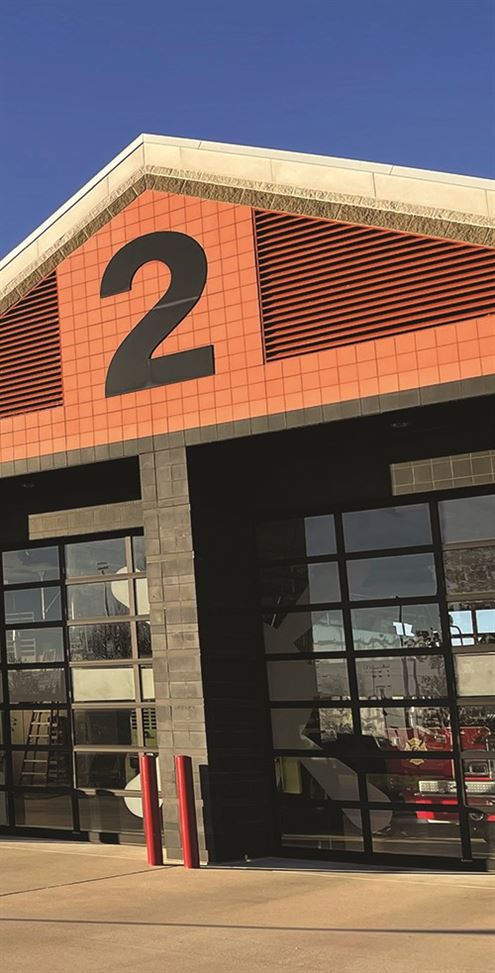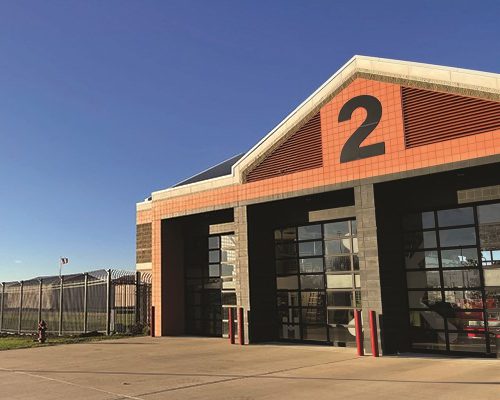Many people wouldn’t live in a home without a fence around it, but tenants at Columbus Municipal Airport (BAK) were perfectly content with a lack of formidable fencing around the general aviation airfield. The same 4-foot tall-farm-style fence surrounded the perimeter of the nearly 80-year-old Indiana airport since 1970.
Many people wouldn’t live in a home without a fence around it, but tenants at Columbus Municipal Airport (BAK) were perfectly content with a lack of formidable fencing around the general aviation airfield. The same 4-foot tall-farm-style fence surrounded the perimeter of the nearly 80-year-old Indiana airport since 1970.
 “Everyone using the airport was very pleased with that standard fence,” says Airport Director Brian Payne. “But we had a lot of issues with people driving across taxi lanes in front of their hangars. There were no other access points.”
“Everyone using the airport was very pleased with that standard fence,” says Airport Director Brian Payne. “But we had a lot of issues with people driving across taxi lanes in front of their hangars. There were no other access points.”
The airport controlled access with coded locks at entry points in the perimeter fencing, and staff changed the key codes frequently. But it never took long for tenants to begin sharing them with others.
“It was a very insecure environment,” Payne recalls. “Everyone from trash truck drivers to Cintas uniform truck drivers went through the gate and dropped off things at the hangars. From a safety and security standpoint, it made me very concerned.”
Then, the Part 139 airport experienced a near miss when a motorcyclist visiting a base tenant drove across a runway in front of an aircraft on final decent. After this incident, Payne decided enough was enough. He notified the FAA and requested help to remedy the situation.
His request landed the airport nearly $3 million in FAA Airport Improvement Program grants for infrastructure and safety improvements.
|
Project: Related Elements: Landside Access Roads & Parking
Location: Cost: $2.79 million Funding: FAA Airport Improvement Program grants Construction: Oct. 2021 Consultant: Woolpert
Fencing Contractor: Access Control System: Summit Control Key Benefits: Increased safety/security for tenants & aircraft operators; enhanced wildlife management |
Payne and his team applied the money toward a large-scale project that included new perimeter fencing, fencing between the airport’s 23 hangars, new back-access drives and parking areas near hangars.
“This is a huge improvement that our airport has needed for some time,” Payne remarks. “We moved from total unimpeded access to a totally secure airport with fences, gates and security.”
The new beefed-up security is more in keeping with an airport of its size and traffic. “We are a small community of just 45,000 people, but [BAK is] the fourth-busiest airport in Indiana,” Payne explains, noting that it averages 140 flight operations a day. “This is a busy airport. We have many corporations and businesses headquartered here. We also have a significant amount of military air traffic, with twice as many operations as other airports with military operations in Indiana. It is essential for us to keep our military men and women safe.”
Culture Shift
The original project design, developed by BAK’s airport engineer, Woolpert Inc., called for 10-foot fencing around the terminal building, surrounding the airport perimeter and between hangars. “We believed it to be the safest and most secure option,” Payne says.
But tenants who were accustomed to unfettered movement on airport grounds saw things differently. They accepted the plan for 10-foot perimeter fencing, but some questioned the need for fencing between hangar buildings.
The airport board listened to tenant input for more than five months before deciding on the safest option for the traveling public. Multiple changes were made during the period of public input, and many other minor modifications were made during the course of the project while working with individual tenants.
In the end, airport officials satisfied the wide range of concerns and objectives by adding access roads on the backside of hangars and installing 4-foot fencing to secure the backside of each hangar building from the general public. The new roads allow tenants and external personnel such as trash collectors and delivery drivers to access hangars from the landside. This facilitates everyday operations for tenants, but boosts airside security and keeps ancillary vehicles off the airfield.

Changing Mindsets
Payne notes that getting tenants on board with the project required a targeted outreach effort.
John Baer, project manager at Woolpert, headed the initiative. Though the pandemic raged on, Baer and key airport team members first considered virtual meetings their best option to gather and understand stakeholder concerns. To minimize risk, they then met with individual tenants at their hangars (rather than meeting en masse) and observed social distancing guidelines.
 “We presented the project and asked for their feedback,” Baer explains of the two-day virtual effort. “We told them we would consider their input, not that we could or could not accommodate each request. There were 60+ based users affected by the project.”
“We presented the project and asked for their feedback,” Baer explains of the two-day virtual effort. “We told them we would consider their input, not that we could or could not accommodate each request. There were 60+ based users affected by the project.”
Input gathered during the various meetings prompted about 20 changes to the project design. Among them, BAK adjusted the fence layout, added driveways and parking lots, and agreed to install security lighting, at the airport’s expense, for tenants who request it.
Assistant Airport Manager Matt Brown explains that adding fences between hangars complicated airside and landside access for tenants who lacked appropriate pedestrian or overhead doors. So BAK responded by installing such doors for 11 tenants, at a cost of $60,000 to the airport.

Tenants also raised security concerns about entering and exiting from the backsides of their hangars. As a result, BAK agreed to add lighting to brighten the areas after hours at each tenant’s request. It also replaced the old code-based access control system with a key fob system to ensure that only authorized people can enter.
 “The system allows us to open and close gates from a computer and assign users key fobs that we can turn on and off,” says Brown. “There are no more generic four-digit access codes that anyone can get their hands on. Now, we issue key fobs that let them in and out, and we can see who comes and goes. We also understand there will be times when tenants need to bring in larger items, and we permit that by turning access on and off from the office.”
“The system allows us to open and close gates from a computer and assign users key fobs that we can turn on and off,” says Brown. “There are no more generic four-digit access codes that anyone can get their hands on. Now, we issue key fobs that let them in and out, and we can see who comes and goes. We also understand there will be times when tenants need to bring in larger items, and we permit that by turning access on and off from the office.”
Tenants even weighed in on the type of fencing that was used. The original project specs called for a chain-link design, but tenants expressed concerns about its aesthetics. In the end, the airport installed an ornamental black iron fence around the terminal building and black PVC-coated chain-link fencing elsewhere.
“It’s not as institutional in appearance as people originally feared,” Payne notes. “In fact, we’ve gotten many compliments on the fence.”
Project Prep
Despite initial concerns about utilities, Baer reports that installation went smoothly. “Every utility you can imagine was within a few feet of the access roads we put in,” he says. “We had to engage the community to coordinate those efforts.”
Because the fences were also installed to keep wildlife off the airfield, project designers needed to make sure they closed all gaps. As such, they had crews bury the 10-foot, three-strand barbed wire perimeter fence 2 feet into the ground to prevent digging by burrowing animals.
Wildlife management was an important issue for the project because BAK is located in a farming community. In fact, crops surround the airport’s 2,000 acres, and BAK farms its undeveloped land to earn extra income. “We don’t take any tax dollars,” explains Payne, stressing the need for the airport to remain self-sufficient. “This meant putting the fence as close to the runway and taxiway surfaces as we could to create the safest operating environment possible, while also allowing farming to continue.”
To keep the airport fully operational while improvements were made, BAK modified existing fencing and installed temporary fencing before the project began.
Positioned for Growth
Before the pandemic hit, BAK had its best year ever with a record 50,966 flight operations. Traffic slowed 16% in 2020 but rebounded nicely. Projections show the airport will break all records by the end of 2021.
“It’s been a great year for us—from operations to fuel sales,” Payne reports. “We continue to invest in all of our buildings and in adding more hangars. Every space we have right now is full and has a significant waiting list. We are currently adding seven condo hangars, and all are pre-leased.”
The fencing project helps set the stage for growth, he adds. “Prospective tenants see it’s a very safe and secure environment. They notice there is better parking, asphalt up to the backside of their hangars, and more,” Payne explains. “They can see what we do to keep our tenants happy.”


 facts&figures
facts&figures

